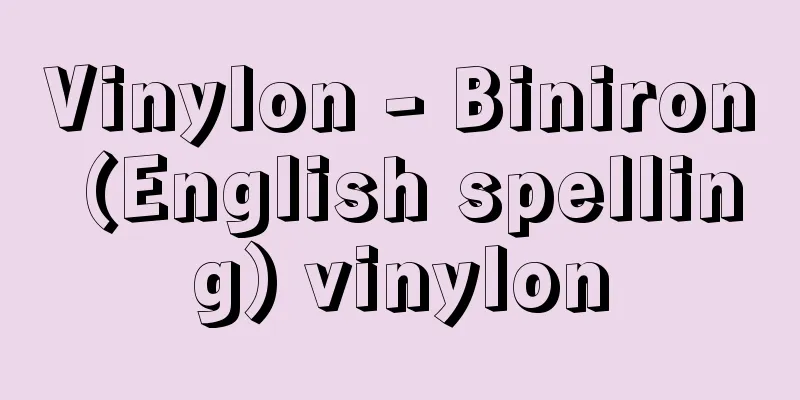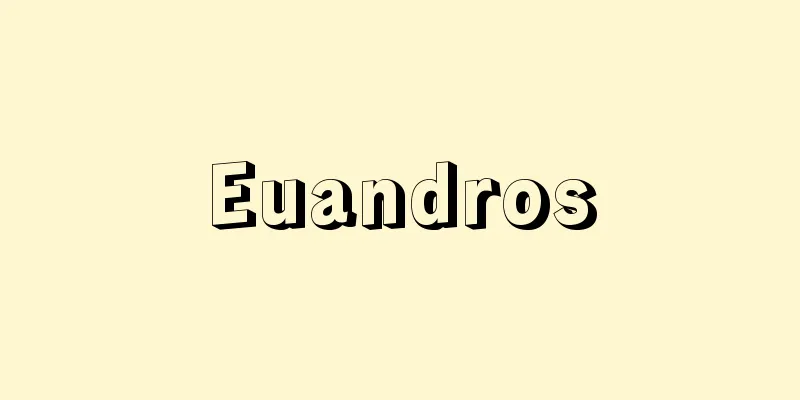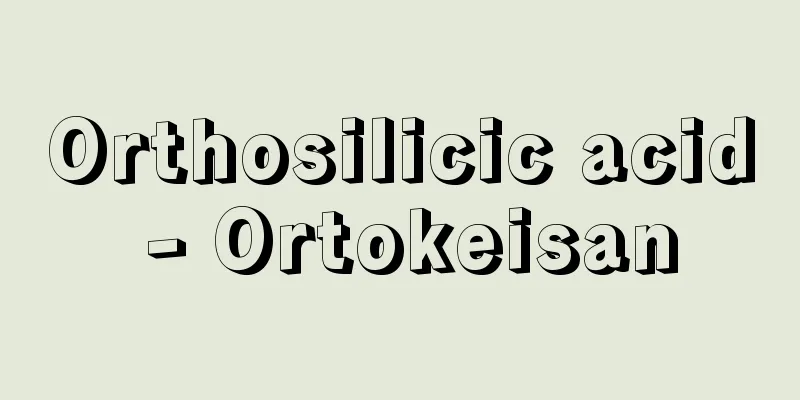Vinylon - Biniron (English spelling) vinylon

|
A general name given to synthetic fibers made from polyvinyl alcohol (abbreviated as PVA). Invented in 1939 (Showa 14) by Ichiro Sakurada and others from Kyoto University, it was sold commercially by Kurashiki Rayon (now Kuraray) in 1950. PVA is a water-soluble polymer obtained by hydrolysis of polyvinyl acetate. PVA is dissolved in water, extruded from a nozzle into a concentrated aqueous solution of sodium sulfate, and wound up while applying appropriate tension and stretching. Since the fiber is soluble in water as is, it is first heat-treated at 130-200°C to improve the crystallinity of the PVA fiber, and then formalized with formaldehyde in the presence of acid. This formalization improves the water resistance of the fiber, turning it into the practical synthetic fiber vinylon. Its properties include the retention of hydroxyl groups in the polymer of the fiber, which makes it more hydrophilic and hygroscopic than other synthetic fibers. Its strength is comparable to that of nylon and polyester, and it has excellent abrasion resistance and durability, but it does not set well when ironed. Taking advantage of these characteristics, it is used for work clothes, school uniforms, fishing nets, ropes, etc. [Hiroshi Kakiuchi] "Fiber-Reinforced Concrete - Focusing on New Fiber Materials" by Shigeyuki Akihama (1992, Kajima Publishing Co.) " "Ohara Soichiro, the Unyielding Idealist" by Taro Inoue (1993, Kodansha) [Reference items] | | | | | | | |©Shogakukan "> Polyvinyl alcohol (PVA) manufacturing method Source: Shogakukan Encyclopedia Nipponica About Encyclopedia Nipponica Information | Legend |
|
ポリビニルアルコール(略号PVA)を原料として得られた合成繊維に与えられた一般名称。1939年(昭和14)に京都大学の桜田一郎らによって発明されたもので、1950年に当時の倉敷レイヨン(現クラレ)から市販された。 PVAはポリ酢酸ビニルを加水分解して得られる水溶性高分子である。PVAを水に溶解し、硫酸ナトリウムの濃厚水溶液中にノズルから吐き出させ、適当な緊張延伸をかけながら巻き取る。このままの繊維は水に可溶であるから、まず繊維を130~200℃で熱処理してPVA繊維の結晶性を向上させ、次に酸の存在下、ホルムアルデヒドでホルマール化する。このホルマール化によって繊維の耐水性が向上し実用的な合成繊維ビニロンになる。 性質は、繊維の高分子中にヒドロキシ基を残しているために、他の合成繊維に比べて親水性が高く吸湿性が大きい。強度はナイロンやポリエステルに劣らず、耐摩擦性、耐久性に優れているが、アイロンによるセット性は低い。用途は、この特徴を生かして作業服、学生服、漁網、ロープなどに用いられている。 [垣内 弘] 『秋浜繁幸著『繊維補強コンクリート――新素材繊維を中心に』(1992・鹿島出版会)』▽『井上太郎著『へこたれない理想主義者 大原総一郎』(1993・講談社)』 [参照項目] | | | | | | | |©Shogakukan"> ポリビニルアルコール(PVA)の製法 出典 小学館 日本大百科全書(ニッポニカ)日本大百科全書(ニッポニカ)について 情報 | 凡例 |
>>: Vinyl greenhouse - Vinyl House
Recommend
Fish Dengaku - Uoden
...The name Dengaku is said to come from the fact...
sippa
...This is an avunculate phenomenon often seen in...
Library stamp - Zoshoin
A seal that is stamped on books to prove ownershi...
Amphipterygidae
...A general term for insects in the family Amphi...
Hay Fever
What kind of disease is it? ●Main symptoms and cou...
Causal Principle - Ingagenri
…By the way, although there are various kinds of ...
Bajau
...The Dan people of Hong Kong, the people who li...
Kurobe [city] - Kurobe
A city in the eastern part of Toyama Prefecture. I...
Cardenas, GLde - Cardenas
...It is a tourist destination known for its adve...
Juan D'Arienzo
1900‐76 Conductor of an Argentine tango orchestra....
HPNS - Hpns
…(4) Disorders associated with pressurization and...
Enharmonic modulation - Enharmonic modulation
…An enharmonic interval is an interval that is no...
Echininus cumingii spinulosus
...On the Pacific coast of Honshu (Kii Peninsula,...
Edam cheese
...It has a mild flavor. (4) Edam cheese Edam che...
Epidural hematoma
Of the three layers of membrane that protect the ...









